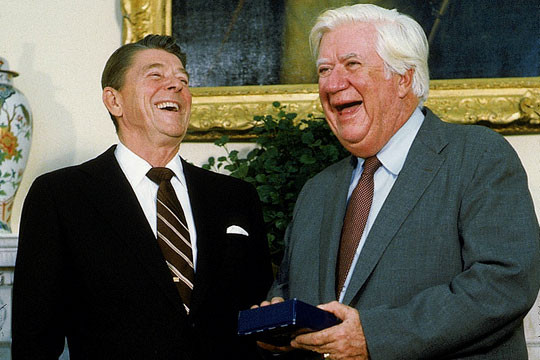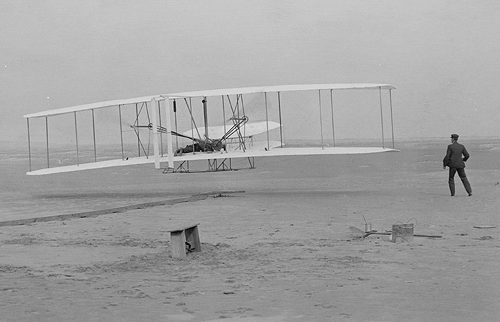Learning through disagreement
 It’s a little-know fact that you can disagree and still be a team player. (Really, it’s true.) It’s okay to disagree, but it should be done effectively. (Disagreement is not argument.) And disagreement can be a great source for learning. I learn most deeply from smart people I disagree with.
It’s a little-know fact that you can disagree and still be a team player. (Really, it’s true.) It’s okay to disagree, but it should be done effectively. (Disagreement is not argument.) And disagreement can be a great source for learning. I learn most deeply from smart people I disagree with.
As a self-declared smart person, I hold my thinking in high regard. (To advance a cause confidence in your thinking is needed.) However, like with most things, there should be balance: confidence in your thinking tempered with healthy self-examination and respect for others’ thinking. There are a lot of smart people out there, people with different life experience, training, and education. Just the folks to learn from. (Different is not inferior or incorrect, it’s just different.)
It’s a struggle to get the balance right. Hold fast? Give a little ground? Change your thinking altogether? There’s no right answer, just the conviction that it’s best to move toward balance.
Trust and mutual respect are keys to our migration toward balance. Trust helps us start deep dialog. It feels safe to initiate when there’s confidence the disagreement comes from a thoughtful, unselfish place. Mutual respect keeps the dialog going – no low blows, just shared thoughts, experiences, and data.
With trust and mutual respect, healthy disagreement has time to blossom into fuller, deeper understanding – a credit to you and the important people in your life.
Coaxing out of the weeds.
 Doing new is difficult and scary. For safety, we create complexity and hide behind it; we swim for the weeds; we dive for the details. (At least we’ll come across as knowledgeable about something when we bury our heads in details.) All of this so we can look smart and feel safe.
Doing new is difficult and scary. For safety, we create complexity and hide behind it; we swim for the weeds; we dive for the details. (At least we’ll come across as knowledgeable about something when we bury our heads in details.) All of this so we can look smart and feel safe.
But with new stuff, looking smart and feeling safe are not valid. With new, we don’t know; we’re not smart (yet); there’s no reason to feel safe. (Don’t try, it’s too slow.)
It takes focus and compassion to coax people out of the weeds and help them feel safe. Focus is needed to keep the end game in mind, to constantly keep context in the forefront (why are we here?), to maintain the right compass heading (into the wind). Compassion is needed to make “I don’t know” feel safe. To start, explain the deal: “new” and “I don’t know” are inseparable, a matched set. Like your best pair of wool socks, left without right doesn’t work. If that’s insufficient, tell them if was easy you’d have asked someone else to do it.
Day-to-day, it’s difficult to maintain focus and compassion. I find it helpful to remember it’s natural to seek safety in the weeds. We all do it. Keep that in mind while you do new as fast as you can.
Improve the US economy, one company at a time.
 I think we can turn around the US economy, one company at a time. Here’s how:
I think we can turn around the US economy, one company at a time. Here’s how:
To start, we must make a couple commitments to ourselves. 1. We will do what it takes to manufacture products in the US because it’s right for the country. 2. We will be more profitable because of it.
Next, we will set up a meeting with our engineering community, and we will tell them about the two commitments. (We will wear earplugs because the cheering will be overwhelming.) Then, we will throw down the gauntlet; we will tell them that, going forward, it’s no longer acceptable to design products as before, that going forward the mantra is: half the cost, half the parts, half the time. Then we will describe the plan.
On the next new product we will define cost, part count, and assembly time goals 50% less that the existing product; we will train the team on DFMA; we will tear apart the existing product and use the toolset; we will learn where the cost is (so we can design it out); we will learn where the parts are (so we can design them out); we will learn where the assembly time is (so we can design it out).
On the next new product we will front load the engineering work; we will spend the needed time to do the up-front thinking; we will analyze; we will examine; we will weigh options; we will understand our designs. This time we will not just talk about the right work, this time we will do it.
On the next new product we will use our design reviews to hold ourselves accountable to the 50% reductions, to the investment in DFMA tools, to the training plan, to the front-loaded engineering work, to our commitment to our profitability and our country.
On the next new product we will celebrate the success of improved product functionality, improved product robustness, a tighter, more predictable supply chain, increased sales, increased profits, and increased US manufacturing jobs.
On the next new product we will do what it takes to manufacture products in the US because it’s the right thing for the country, and we will be more profitable because of it.
If you’d like some help improving the US economy one company at a time, send me an email (mike@shipulski.com), and I’ll help you put a plan together.
a
p.s. I’m holding a half-day workshop on how to implement systematic cost savings through product design on June 13 in Providence RI as part of the International Forum on DFMA — here’s the link. I hope to see you there.
The carry-over task and fear of success
 The to-do list, whether digital or analog, we’ve all got ’em. We cross things off and put things on (mostly the latter); the list evolves – it’s a living thing.We put energy into adding things, tasks, action items. (You can’t go to a meeting without collecting one of them.)
The to-do list, whether digital or analog, we’ve all got ’em. We cross things off and put things on (mostly the latter); the list evolves – it’s a living thing.We put energy into adding things, tasks, action items. (You can’t go to a meeting without collecting one of them.)
But most telling to me are the tasks that stay on week-on-week, the carry-over tasks. We never do them, but we never take them off the list. What are they? Why don’t we do them? Why don’t we just take them off the list?
For tasks we complete, the fundamental motivating force is fear, fear of not getting them done, the consequences of failure. The deal is clear: we don’t complete the task, and something bad will happen to us. We know what will happen to us if we fail, we know the consequences of failure.
But the carry-over task is altogether a different beast. It’s an uncompleted task where the fundamental motivating force is still fear, but this time it’s the fear of getting them done, the consequences of success. The deal is absolutely unclear: we complete the task, and something good will happen to us. Though, this time we don’t know what will happen to us if we succeed, we don’t know the consequences of success.
With the carry-over task, we must supply our own motivation, our own energy, to overcome the consequences of something good happening to us us. Strange, but true.
With success comes visibility; with visibility comes judgement; with judgement comes fear, fear of being un-liked. We will be seen for what we are, and we’re afraid of what people will think. Some won’t like us, and that’s scary.
The fear of success is real, and it’s a tough nut. Some many not want to crack it, and that’s okay. For those that do, consider this: today, as you are, some don’t like you, so how could success be worse? With success, at least they’ll know why they don’t like you: because you succeeded.
For innovation, look inside.
 Everyone is dissatisfied with the pace of innovation – solutions that change the game don’t come fast enough. We look to the environment, and assign blame. We blame the tools, the process, the organization structure, and the technology itself. But the blame is misplaced. It is the innovators that govern the pace of innovation.
Everyone is dissatisfied with the pace of innovation – solutions that change the game don’t come fast enough. We look to the environment, and assign blame. We blame the tools, the process, the organization structure, and the technology itself. But the blame is misplaced. It is the innovators that govern the pace of innovation.
It certainly isn’t the technology – the solutions already exist; they’re patiently waiting for us, waiting for us to find them. We just have to look. The technology knows what it will be when it grows up: the path is clear. Put simply, we must break through our unwillingness to look. We must look harder, deeper, and more often. We must redefine our self-set limits, and look under the rocks of our successes and beyond our best work.
To increase the pace and quality of innovation, we must look inside.
a
a
p.s. I’m holding a half-day workshop on how to implement systematic cost savings through product design on June 13 in Providence RI as part of the International Forum on DFMA — here’s the link. I hope to see you there.
The obligations of knowing your stuff.
If you know your shit, you have an obligation to behave that way:
Do – don’t ask.
Say, “I don’t know.”
Wear the clothes you want.
Tread water with Fear until she drowns.
Walk softly – leave your big stick at home.
Ask people what they think – let them teach you.
Kick Consensus in the balls – he certainly deserves it.
Be kind to those who should know – teach, don’t preach.
Hug the bullies – they cannot hurt you, you know too much.
Work with talented new folks – piss and ginger is a winning combination.
In short, use your powers for good – you have an obligation to yourself, your family, and society.
Obsolete your best work.
 You solved a big problem in a meaningful way; you made a big improvement in something important; you brought new thinking to an old paradigm; you created something from nothing. Unfortunately, the easy part is over. Your work created the new baseline, the new starting point, the new thing that must be made obsolete. So now on to the hard part: to obsolete your best work
You solved a big problem in a meaningful way; you made a big improvement in something important; you brought new thinking to an old paradigm; you created something from nothing. Unfortunately, the easy part is over. Your work created the new baseline, the new starting point, the new thing that must be made obsolete. So now on to the hard part: to obsolete your best work
You know best how to improve your work, but you must have the right mindset to obsolete it. Sure, take time to celebrate your success (Remember, you created something from nothing.), but as soon as you can, grow your celebration into confidence, confidence to dismantle the thing you created. From there, elevate your confidence into optimism, optimism for future success. (You earned the right to feel optimistic; your company knows your next adventure may not work, but, hey, no one else will even try some of the things you’ve already pulled off.) For you, consequences of failure are negligible; for you, optimism is right.
Now, go obsolete your best work, and feel good about it.
I can name that tune in three notes.
 More with more doesn’t cut it anymore, just not good enough.
More with more doesn’t cut it anymore, just not good enough.
The behavior we’re looking for can be nicely described by the old TV game show Name That Tune, where two contestants competed to guess the name of a song with the fewest notes. They were read a clue that described a song, and ratcheted down the notes needed to guess it. Here’s the nugget: they challenged themselves to do more with less, they were excited to do more with less, they were rewarded when they did more with less. The smartest, most knowledgeable contestants needed fewer notes. Let me say that again – the best contestants used the fewest notes.
In product design, the number of notes is analogous to part count, but the similarities end there. Those that use the fewest are not considered our best or our most knowledgeable, they’re not rewarded for their work, and our organizations don’t create excitement or a sense of challenge around using the fewest.
For other work, the number of notes is analogous to complexity. Acknowledge those that use the fewest, because their impact ripples through your company, and makes all your work easier.
Pull the product lever, now.
 If you’re reading this you’ve probably survived the great recession. You had to do some radical stuff, but you pulled it off. You cut to the bone as demand fell off, but you managed to shed staff and capacity and kept your company alive. Congratulations. Amazing work. But now the hard part: increased demand!
If you’re reading this you’ve probably survived the great recession. You had to do some radical stuff, but you pulled it off. You cut to the bone as demand fell off, but you managed to shed staff and capacity and kept your company alive. Congratulations. Amazing work. But now the hard part: increased demand!
Customers are ordering, and they want product now. You’re bringing on capacity, re-hiring, and re-training, and taking waste out of your processes with lean and even extending lean to your supply chain and logistics. You’re pulling the levers as hard as you can, but you know it won’t be enough. What you need is another lever, a big, powerful, magical lever to make everything better. You need to pull the product lever.
So, you’re telling me to look at my product as a way to meet increased demand? Yes. To get more products out of few factories? Yes. To make more products with a short staff? Yes. To reduce supply chain complexity? Yes. Pull the product lever, pull it hard, and pull it now.
But meeting increased demand is a manufacturing/supply chain problem, right? No. What about flogging suppliers for unreasonably short lead times? No. What about quickly bringing on unproven suppliers? No. What about bringing on a totally new factory by next week? No. What about using folks of the street to make the product? No. Pull the product lever, pull hard, and pull it now.
Dust off the value stream map of your supply chain and identify the three longest lead times, and design them out of your product. Dust off your routings and identify the three largest labor times, and design them out of our product. Dust off your BOMs and identify the three highest cost parts, and design them out of your product. Pull the product lever. Then, identify the next three, and pull it again. Then repeat. Pull it hard, and pull it now.
Meeting increased demand will be challenging, but your customers and stockholders deserve your best. So, pull hard on all your levers, and pull them now.
Missing Element of Lean – Assembly Magazine article
 With its strong focus on waste reduction of processes, lean has been a savior for those who’ve made it out of the great recession. But what’s next? I argue the next level of savings will come from adding a product focus to lean’s well-developed process focus. For the complete Assembly Magazine article (one page), click here.
With its strong focus on waste reduction of processes, lean has been a savior for those who’ve made it out of the great recession. But what’s next? I argue the next level of savings will come from adding a product focus to lean’s well-developed process focus. For the complete Assembly Magazine article (one page), click here.

 Mike Shipulski
Mike Shipulski